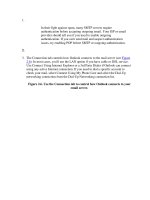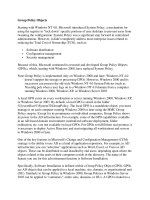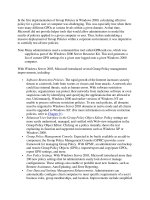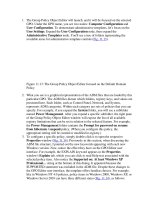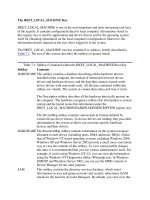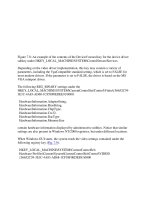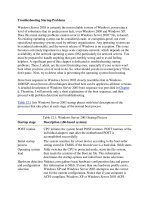Tài liệu The Spotlight Window phần 2 pdf
Bạn đang xem bản rút gọn của tài liệu. Xem và tải ngay bản đầy đủ của tài liệu tại đây (36.32 KB, 7 trang )
•
today, yesterday, this week, this month, this year. These commands in the second
pop-up menu offer quick, canned time-limiting options.
•
within last, exactly, before, after let you be more precise. If you choose Before,
After, or Exactly, your criterion row sprouts a month/day/year control that lets you
round up items that you last opened or changed before, after, or on a specific day,
like 5/27/08. If you choose "within last," you'll see that you can limit the search to
things you've opened or changed within a specified number of days, weeks,
months, or years.
These are awesomely useful controls, because they let you specify a chronological
window for whatever you're looking for.
Tip: You're allowed to add two Date rows—a great trick that lets you round up files that
you created or edited between two dates. Set up the first Date row to say "is after," and
the second one to say "is before."In fact, if it doesn't hurt your brain to think about it, how
about this? You can even have more than two Date rows. Use one pair to specify a range
of dates for the file's creation date, for example, and two other rows to limit when it was
modified.Science!
3.2.7.3. Name
The beauty of Spotlight is that it finds text anywhere in your files, no matter what their
names are. That's why Apple demoted this option—the icon's name—to such a low
position in the pop-up menu.
Anyway, when you want to search for an icon by the text that's only in its name, this is
your ticket. Capitalization doesn't matter.
Of course, if all you want to do is find files whose names include Sales, you may as well
save yourself all of this reading and use the Spotlight menu (or click the File Name
button at the top of the window). But using the Search window offers you far more
control, thanks to the second pop-up menu that offers you these options:
•
Contains. The position of the letters you type doesn't matter. If you type then, you
find files with names like "Then and Now," "Authentic Cajun Recipes," and
"Lovable Heathen."
•
Starts with. The Find program will find only files beginning with the letters you
type. If you type then, you find "Then and Now,"but not "Authentic Cajun
Recipes" or "Lovable Heathen."
•
Ends with. If you type then, you find "Lovable Heathen,"but not files called "Then
and Now" or "Authentic Cajun Recipes."
•
Is.This option finds only files named precisely what you type (except that
capitalization still doesn't matter). Typing then won't find any of the file names in
the previous examples. It would unearth only a file called simply "Then." In fact, a
file with a file name suffix, like "Then.doc," doesn't even qualify.
(If this happens to you, though, here's a workaround: From the first pop-up menu,
choose Other; in the dialog box, pick Filename. The Filename criterion ignores
extensions; it would find "Then.doc" even if you searched for "then.")
3.2.7.4. Contents
You can think of this option as the opposite of Name. It finds only the text that's inside
your files, and completely ignores their icon names.
That's a handy function when, for example, a document's name doesn't match its contents.
Maybe a marauding toddler pressed the keys while playing KidPix, inadvertently
renaming your doctoral thesis "xggrjpO#$5%////." Or maybe you just can't remember
what you called something.
WORKAROUND WORKSHOP
Feeding the Barren Pop-up Menus
The first little pop-up menu in the Spotlight window lists those handy search
starting points: Kind, Last opened date, Name, and so on.
But it's actually less fully stocked than it was in Mac OS Xes of days gone by.
Apple streamlined the options a bit.
For example, you used to be able to search by label (Section 2.5). You could
therefore easily round up all files pertaining to a certain project for backing up,
deleting, or burning to a CD en masse. That's off the menu as you first see it.
Gone, too, is the Size criterion, which could be helpful when you're trying to
make space on your overstuffed hard drive by ferreting out the huge,
multigigabyte files and folders.
Fortunately, you can restore these options to the criterion pop-up menu easily
enough. The trick is to use the Other option as described on these pages. In the
dialog box shown in Figure 3-4, search for label or size. When you find that
criterion, turn on the "In menu" checkbox and click OK.
Presto: You've got your menu back.
3.2.7.5. Other
If this were a math equation, it might look like this: options x options=overwhelming.
Choosing Other from the first pop-up menu opens a special dialog box containing at least
125 other criteria. Not just the big kahunas like Name, Size, and Kind, but far more
targeted (and obscure) criteria like "Bits per sample" (so you can round up MP3 music
files of a certain quality), "Device make" (so you can round up all digital photos taken
with, say, a Canon camera), "Key signature" (so you can find all the GarageBand songs
you wrote in the key of F sharp), "Pages" (so you can find all Word documents that are
really long), and so on. As you can see in Figure 3-4
, each one comes with a short
description.
Figure 3-4. Here's the master list of search criteria. Turn on the "In menu"
checkboxes of the ones you'll want to re-use often, as described in the box on the
previous page. Once you've added some of these search criteria to the menu, you'll
get an appropriate set of "find what?" controls ("Greater than"/"Less than" pop-
up menus, for example).
You may think that Spotlight is offering you a staggering array of file-type criteria. In
fact, though, big bunches of information categories (technically called metadata) are all
hooks for a relatively small number of document types. For example:
•
Digital photos and other graphics files account for the metadata types alpha
channel, aperture, color space, device make, device model, EXIF version,
exposure mode, exposure program, exposure time, flash, FNumber, focal length,
ISO speed, max aperture, metering mode, orientation, pixel height, pixel width,
red eye, resolution height, resolution width, and white balance.
•
Digital music files have searchable metadata categories like album, audio bit rate,
bits per sample, channel count, composer, duration, General MIDI sequence, key
signature, lyricist, musical genre, recording date, sample rate, tempo, time
signature, track number, and year recorded. There's even a special set of
parameters for GarageBand and Soundtrack documents, including, instrument
category, instrument name, loop descriptors, loop file type, loop original key, and
loop scale type.
•
Microsoft Office documents can contain info bits like authors, contributors, fonts,
languages, pages, publishers, and contact information (name, phone number, and
so on).
This massive list also harbors a few criteria you may use more often, like Size, Label, and
Visibility (which lets you see all the invisible files on your hard drive). See the box on
Section 3.2.7.4
.
Now, you could argue that in the time it takes you to set up a search for such a specific
kind of data, you could have just rooted through your files and found what you wanted
manually. But hey—you never know. Someday, you may remember nothing about a
photo you're looking for except that you used the flash and an F-stop of 1.8.
Tip: Don't miss the Search box in this dialog box. It makes it super-easy to pluck one
useful criterion needle—Size, say—out of the haystack. Also don't forget about the "In
menu" checkbox in the right column. It lets you add one of these criteria to the main pop-
up menu, so you don't have to go burrowing into Other again the next time.
3.2.8. What to Do with Search Results
The Spotlight window has been drastically simplified since the last version of Mac OS X;
it's now a regular old Finder window, with all the familiar views and controls (Figure 3-
5).
Figure 3-5. Click a result once to see where it sits on your hard drive (very bottom).
If the window is too narrow to reveal the full folder path, run your cursor over them
without clicking. As your mouse moves from one folder to another, Leopard briefly
reveals its name, compressing other folders as necessary to make room. (Sub-tip:
You can drag icons into these folders, too.)
You can work with anything in the results window exactly as though it's a regular Finder
window: Drag something to the Trash, rename something, drag something to the desktop
to move it there, drag something onto a Dock icon to open it with a certain program,
Option- -drag it to the desktop to create an alias, and so on.
You can move up or down the list by pressing the arrow keys, scroll a "page" at a time
with the Page Up and Page Down keys, and so on. You can also highlight multiple icons
simultaneously, the same way you would in a Finder list view: Highlight all of them by
choosing Edit Select All; highlight individual items by -clicking them; drag
diagonally to enclose a cluster of found items; and so on.
Or you can proceed in any of these ways:
•
Change the view by clicking one of the View icons or choosing from the View
menu. You can switch between icon, list, or Cover Flow views (see Chapter 1
).
Actually, Cover Flow is a great view for search results; since this list is culled
from folders all over the computer, you otherwise have very little sense of context
as you examine the file names.
Note: Column view isn't available here, since the search results displayed here are
collected from all over your computer. They don't all reside in the same folder.
Still, Apple's given you a consolation prize here: the folder path display at the
bottom of the window. It tells you where the selected item is hiding on your hard
drive just as clearly as column view would have.
•
Sort the results by clicking the column headings (not available in icon view). It
can be especially useful to sort by Kind, so that similar file types are clustered
together (Documents, Images, Messages, and so on), or to sort by Last Opened, so
that the list is chronological.
•
Get a Quick Look at one result by clicking it and then hitting the Space bar. If it's
a document type that Mac OS X understands (see Section 1.8.1
), you get the big,
bold Quick Look preview window.
POWER USERS' CLINIC
All Roads Lead to Spotlight
As you know, you can open the Spotlight window using a keystroke or from the
Spotlight menu after performing a search.
But those methods are only the beginning.
Try this: Highlight a phrase in any program (except Microsoft ones and a few
other weirdos). Control-click (or right-click) the highlighted phrase, and then


